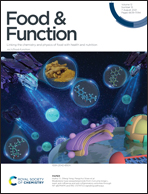Biogenic selenium nanoparticles by Lactobacillus casei ATCC 393 alleviate the intestinal permeability, mitochondrial dysfunction and mitophagy induced by oxidative stress
Abstract
Selenium (Se) is an essential trace element. Nano-selenium has attracted great attention due to its various biological properties, especially strong antioxidant activity, high bioavailability, and low toxicity. Our previous studies demonstrated that the selenium nanoparticles (SeNPs) synthesized by Lactobacillus casei ATCC 393 (L. casei ATCC 393) alleviate hydrogen peroxide (H2O2)-induced intestinal epithelial barrier dysfunction via the mitochondrial pathway. However, the mechanism of SeNPs exerting antioxidant activity through the mitochondrial pathway remains unclear. This study was conducted to investigate the role of mitophagy in the protective effects of SeNPs on H2O2-induced porcine intestinal epithelial cells against oxidative damage. The results showed that the SeNPs synthesized by L. casei ATCC 393 had no cytotoxicity on IPEC-J2 cells and effectively antagonized the cytotoxicity of 500 μM H2O2 on IPEC-J2 cells. Moreover, SeNPs attenuated the H2O2-induced intestinal epithelial barrier dysfunction and ROS overproduction, as well as alleviated the adenosine triphosphate (ATP) level and the mitochondrial membrane potential (MMP) decrease. In addition, compared to the oxidative stress model group, pretreatment with biogenic SeNPs significantly up-regulated the expression levels of occludin and claudin-1. Moreover, when compared to the oxidative stress model group, SeNPs inhibited the phosphorylation level of the mammalian target of rapamycin (m-TOR), as well as the expression levels of Unc-51-like kinase 1(ULK1), light chain 3 (LC3)-II/LC3-I, PTEN-induced kinase 1 (PINK1) and Parkin proteins. The fluorescence colocalization images of mitochondria and lysosomes demonstrated that SeNPs significantly reduced the fusion of mitochondria and lysosomes when compared to the oxidative stress model group. These results demonstrate that the SeNPs synthesized by L. casei ATCC 393 can effectively alleviate the H2O2-induced intestinal epithelial barrier dysfunction through regulating mTOR/PINK1-mediated mitophagy.



 Please wait while we load your content...
Please wait while we load your content...